How to Overcome Ageism in the Workplace
Contents
Contents
Age Discrimination in the Workplace
Age discrimination or “ageism” involves stereotyping or discriminating against an individual due to their age. Unfortunately, workplace age bias is alive and well across diverse industries and businesses. For quite some time, it has been the elephant in the room. However, thanks to social media platforms, advocacy, and federal legislation, ageism is getting much-needed attention.
AARP surveyed 3,900 individuals aged 45 and older who were either employed or seeking employment. The findings revealed that two out of three employees claimed they had witnessed or experienced ageism at work. Among the 61% of respondents who reported age bias, 91% believe such discrimination is widely practiced.
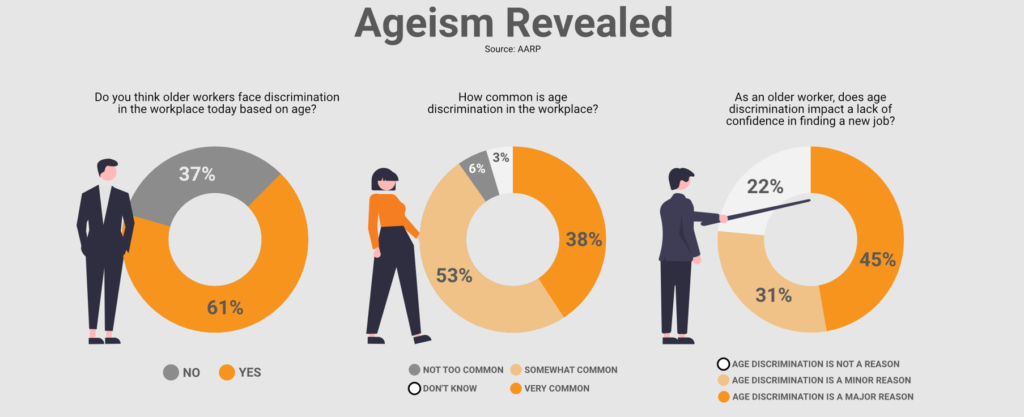
Legally, US employers are prohibited from hiring, firing, or promoting employees, and determining an employee’s compensation based on age. In 1967, the United States Congress enacted the Age Discrimination in Employment Act (ADEA), prohibiting employment discrimination against individuals 40 years of age or older.
According to the ADEA, “It is, therefore, the purpose of this chapter to promote employment of older persons based on their ability rather than age; to prohibit arbitrary age discrimination in employment; to help employers and workers find ways of meeting problems arising from the impact of age on employment” (United States Equal Employment Opportunity Commission).
Even with the positive intentions of the ADEA, ageism is still practiced in many organizations. In recent years, Congress has revisited this issue by considering updated legislation on anti-age discrimination in hiring practices, including The Protecting Older Workers Against Discrimination Act and Protect Older Job Applicants Act of 2021.
According to VANTAGE Aging, a nonprofit organization for older adults, companies can face legal actions for age discrimination and/or resulting distrust from their own staff. “Many states have also initiated their own laws against ageism in the workplace. Businesses are not allowed to make employment decisions based on age. By doing so, they might face legal liability. Employees can sue a business for age discrimination, often resulting in large fines and a damaged business reputation.”
Despite federal and local efforts to combat workplace age discrimination, it continues to occur. And it can be conducted covertly or it can be blatantly overt.
In fact, according to an investigation by The New York Times and ProPublica, some large and well-known organizations have engaged in ageism by launching recruitment campaigns but limiting advertisements to specific, younger age groups (Society of Human Resource Management).
“Sometimes in candidate evaluations, words like ‘tired’ or ‘not energetic’ appear as a reason to reject a candidate. It’s a way to mask age discrimination, and people might not even be aware that they’re doing it,” said Oneida Blagg, former executive officer for equity, diversity, and inclusion for a group of community colleges in Washington state.
A Negative Environment
The harmful impacts of workforce age discrimination are not limited to older employees. It affects women and men across the age spectrum. Younger staff may feel apprehensive about eventually being the next target or will not want to continue working for a company that discriminates against their team members.
A study published in the Journal of Gerontology shows women who experience workplace ageism have an increased risk of mental health issues. Age discrimination also results in financial strain and threatens financial independence, which can produce depressive symptoms.
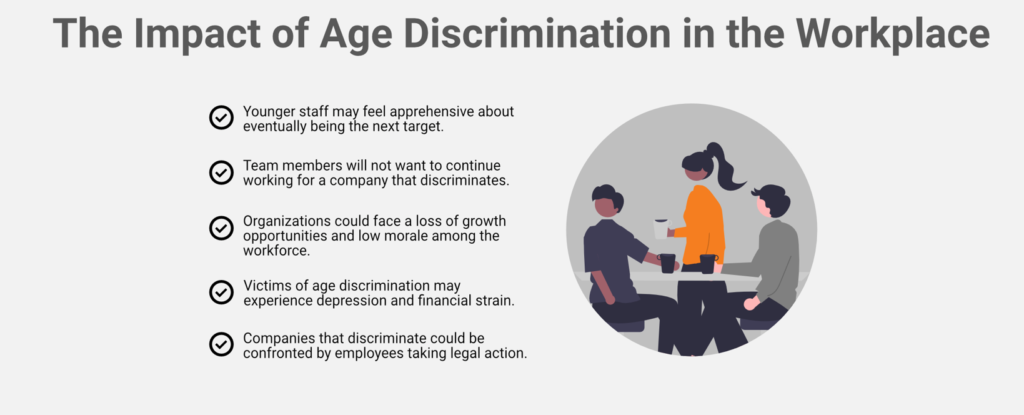
Businesses that practice workplace ageism are more likely to experience low productivity and high turnovers. Low morale and an inconsistent workforce deprive a business of long-term growth opportunities.
Tackling Age Discrimination in a Job Search
If you’re over age 40, strategize a plan to remain relevant in your profession, and set yourself up for success, and avoid ageism in the workplace.
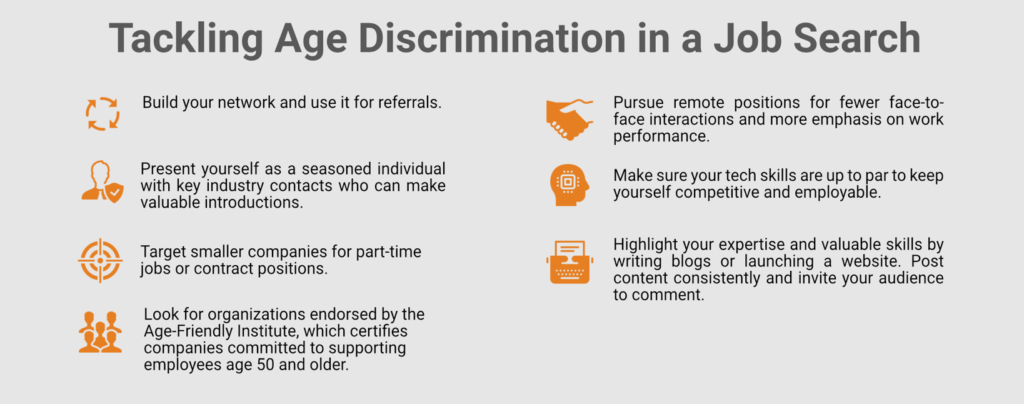
As a job seeker, you can take steps to avoid potential age bias from employers and recruiters.
- Build your network and use it for referrals. Lobby for a recommendation from someone whom the potential employer already knows;
- Present yourself as a seasoned individual with key industry contacts who can make valuable introductions. If viewed as an industry authority, people will seek your skills and knowledge;
- Target smaller companies for part-time jobs or contract positions. Smaller companies may need the knowledge and expertise you gained from a larger and more established organization;
- Pursue remote positions for fewer face-to-face interactions and more emphasis on work performance;
- Make sure your tech skills are up to par to keep yourself competitive and employable;
- Highlight your expertise and valuable skills by writing blogs or launching a website; post content consistently and invite your audience to comment. Reach out to other industry pages to request guest content; and
- Look for organizations certified through the Age-Friendly Institute’s Certified Age Friendly Employer (CAFÉ) program to identify organizations that are welcoming to employees aged 50+.
Enhance Your Skills and Reputation
Never claim you’re “too old” to learn new skills or earn a certificate/license. It’s crucial to be relevant and marketable. Many companies reimburse employees for completing continuing education programs, including webinars and tutorials. If not, there are free online learning classes via a search engine.
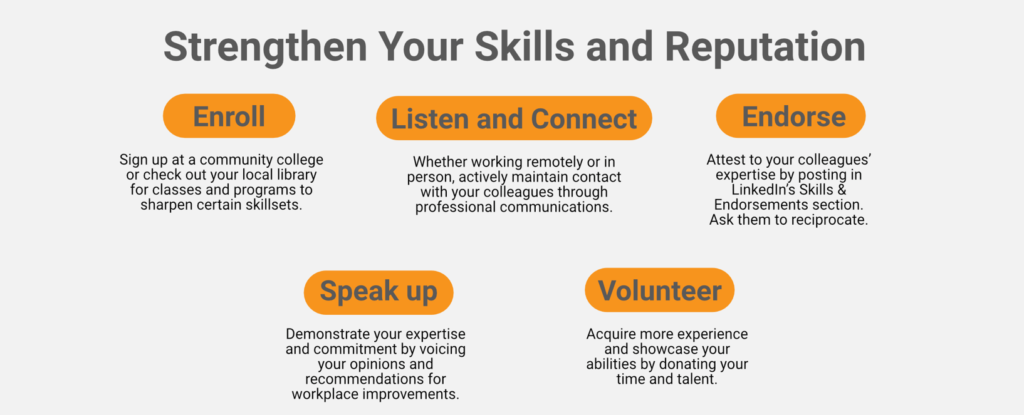
Enroll. Sign up at a community college or check out your local library for classes and programs to sharpen certain skill sets. You can also improve your negotiation skills, customer service tactics, and problem-solving abilities.
Email effectively. Communicating via email is commonplace. Remember to include a subject heading and a greeting. Keep the content concise and proofread your message before sending it. Check for grammatical and spelling errors and make sure you inserted the correct punctuation marks. Select a font size that is not too large or too small.
Listen and Connect. Whether working remotely or in person, please put away your phone and minimize distractions. Maintain contact with your colleagues. Coordinate a happy hour to simply socialize and take advantage of the setting to introduce professionals who may benefit from knowing one another.
Endorse. Attest to your colleagues’ expertise by posting in LinkedIn’s Skills & Endorsements section. Your LinkedIn connections can return the favor and endorse your competencies. “Including skill endorsements in your profile can help you rank higher in LinkedIn search, build your personal brand, and attract the attention of recruiters and hiring managers,” says Alison Doyle in How to Get and Give Endorsements on LinkedIn.
Speak up. Voice your opinions and recommendations in the workplace and show others you care to improve and streamline operations. Manifest confidence in yourself and your position within the company.
Volunteer. Giving your time to an organization helps you not only showcase your talents but acquire more experience with new skills. Contact leadership to discuss if any volunteer roles would be a good fit with your expertise.
Optimize Your Resume & LinkedIn Profile
It’s also important to update career success tools such as your resume and LinkedIn profile to shine the spotlight on your recent expertise, accomplishments, and abilities rather than your past history.
- Do not disclose the dates you completed your education and professional development training;
- Do not bold dates of your various tenures with companies; emphasize your achievements rather than the number of years you’ve been employed with organizations;
- Focus on the most recent 10-15 years of your professional experience instead of your entire career; employers are more interested in your most recent employment history.
- Create a new email account if you have an @aol.com address; AOL is archaic and has a negative image; and
- Identify relevant extracurricular activities; emphasize your presence in your local community and promote yourself as a well-rounded and active individual.

Tremendous Value of Older Workers
It is a commonly held belief that with age comes experience. So why are younger employees preferred at times? Some executives are concerned that if they do not recruit younger staff, their organizations will not be able to adapt to emerging technologies. Others feel mature job seekers will retire soon and demand high salaries.
However, younger staff may lack the valuable knowledge that an older worker has acquired over time. Further, older employees often manifest more maturity and confidence in their professional skills and abilities. This mindset is paramount for efficient job performance and helps a business maintain its reputable image as an industry expert. Long-term survival is key for companies.
“Older workers are a great value to employers,” says Susan Weinstock, vice president of financial resilience programming for AARP. “Employers are looking for people with soft skills, like being good with teamwork or collaboration or being able to write well. These are skills older workers have developed through their years of experience.”
Growing older can be a positive experience that benefits all. Older workers can serve as mentors, passing their knowledge and expertise to younger and less experienced colleagues. Younger and older workers alike can deploy valuable skills. Age diversity enhances company
Share the Full Ageism in the Workplace Infographic
Would you like to share our infographic on your website? That’s great! All we ask is that you include a link back to this page on our site. (Thanks!)
To save the full infographic below, simply right-click and select “save image as” to save it to your drive.
How We Help Professionals Like You
We work exclusively with executive-level professionals like you. By leveraging our decades of experience and our proven process, our clients get hired faster and negotiate higher compensation packages. Our approach is to uncover your unique talent brand, the things that truly make you the best candidate for an executive position.
|
Resume Writing
|
Interview Prep
|
Career Coaching
|
The Power of a Professional Executive Resume
What does your personal brand say about you? Experienced executives leverage our team of certified resume writing experts to position them as the expert in their field.
You need more than just a resume; you will also need a cover letter, LinkedIn profile, and professional biography.

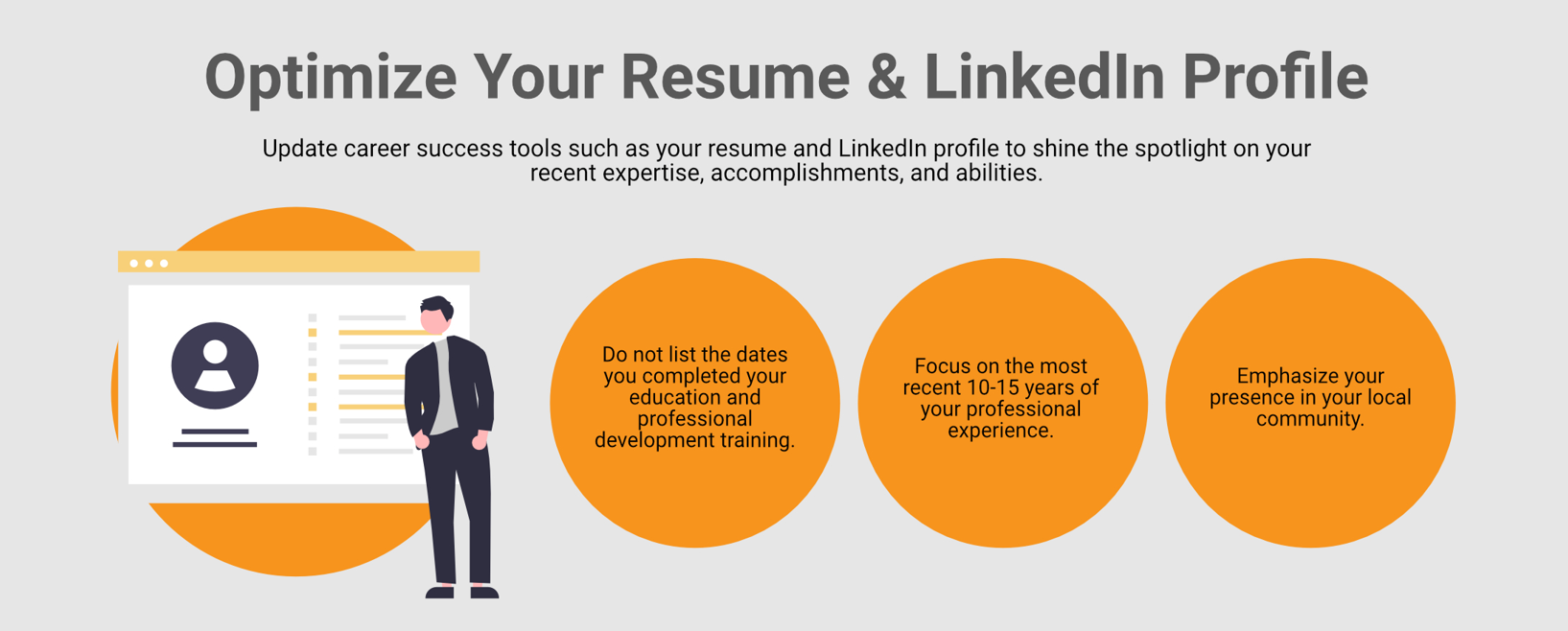


Leverage Social Media to Combat Ageism
During the last two decades, social media platforms have evolved and become a legitimate source for professional contacts to connect. Maximize your social media accounts by creating posts highlighting organizations where you made a positive impact.
You may also tag (with permission) current and former coworkers who mentored and assisted you during your career path. This is an opportunity to develop a sense of community while strengthening relationships with your professional network.
Remember also to list any social media profiles on your resume so a potential employer can see you’re comfortable with the different platforms. In addition, follow the key industry players on Twitter, Facebook, and Instagram to stay informed on current conversations related to your field.
Utilize popular online social media channels such as LinkedIn and YouTube as resources to find free webinars, along with software navigation and various how-to tutorials. (Of course, you should confirm reputable sources produce the videos you are watching.)
There are available classes on additional platforms, including edX.org, Coursera, Udemy, Skillshare, and GetSetUp.io, a learning community targeting individuals over age 50. And LinkedIn offers a free trial month of their LinkedIn Learning courses to help you brush up on your work skills.